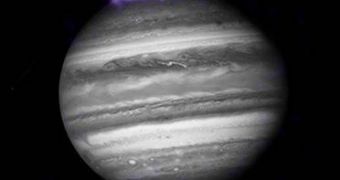The aurora is a bright glow observed in the night sky, usually in the polar zones of Earth, as if the sun were rising from an unusual direction.
In northern latitudes, it is known as the aurora borealis, named after the Roman goddess of the dawn, Aurora, and the Greek name for north wind, Boreas. Its southern counterpart, the aurora australis - the Latin word for "of the South" has similar properties.
Earth isn't the only planet that knows this strange phenomenon.
NASA's Chandra X-ray Observatory has captured the largest data set yet of Jupiter's colorful lights, yielding a pretty picture that could help solve some mysteries about the phenomenon.
"Jupiter has auroras bigger than our entire planet," said Randy Gladstone of the Southwest Research Institute in San Antonio, Texas. In a NASA statement today, Gladstone called the purple rings in a new colorized image "Northern Lights on steroids. They're hundreds of times more energetic than auroras on Earth."
On Earth, the most intense auroras are caused by charged particles unleashed in solar storms. But Jupiter generates its own lights, Gladstone explained. The giant planet turns on it axis once every 10 hours and drags its planetary magnetic field around with it. This spin produces 10 million volts around its poles.
This means that, unlike those on Earth, Jupiter's hyper-auroras never stop, because its polar regions are crackling with electricity.
Furthermore, Jupiter' s volcanic moon Io feeds particles of oxygen and sulfur into Jupiter's system, that become charged and contribute to the lights, and the scientist are still trying to figure out how volcanic exhaust from Io travels through Jupiter's atmosphere and back to Jupiter's poles.
The most intriguing mystery surrounding these alien auroras is the fact it there seems to be some sort of X-ray "pulsar" inside Jupiter's northern auroras, that the observatory sometimes sees, and sometimes doesn't. But when it's active, the pulsar emits gigawatt bursts of X-rays at a regular 45 minutes interval.
Could it be solar powered, or is it something more to it that scientists don't yet fully understand ?
"Maybe Jupiter's magnetic field, when it gets hit by a solar wind gust, rings like a bell with a 45-minute period," Gladstone speculates. "There are many other possibilities as well."

 14 DAY TRIAL //
14 DAY TRIAL //